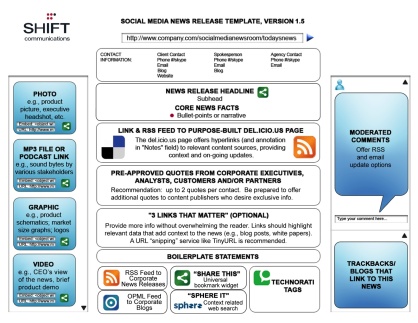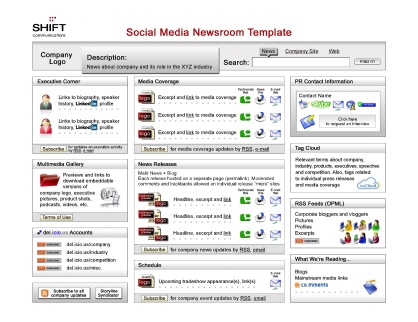Online Newsroom WrapUp…the take away message
April 9, 2009
No one should fret when they hear the words “online newsroom” because it really is not a scary concept. In fact, they are an innovative and creative way of presenting information to those who are interested. An online newsroom is a place where relationships begin and grow into symbiotic relationships.
Through my research, I have gained a love for online newsrooms and truly believe they are one of the most important tools a company can have in their toolbox. These newsrooms provide such a huge opportunity for a company. To summarize the importance of online newsrooms, I would like to share my take away message, which is three-fold.
First, online newsrooms provide 24/7 news that is updated in real-time. This means that the second something is published in the company newsroom, anyone on the web can access it. Individuals no longer have to wait until the next day or several days later to hear about news within a company. If a crisis emerges, the 24/7 capability makes online newsrooms the perfect way for a company to keep its employees, consumers and the media informed of the most current developments.
Second, there are a number of elements in the ideal online newsroom that make it so news worthy. These include: searchable press releases, photos or other images, executive bios, audio (ex: speeches, podcasts, presentations), videos, an events calendar and PR contacts. Each of these helps journalist do his or her job AND makes sure the company voice is heard. Without these elements, journalists could get frustrated with trying to find information and the media coverage a company gets may not be accurate or all that positive.
Thirdly, there are a number of publics (journalists, employees and consumers) that use a company’s online newsroom for information; therefore, it is wise to make sure they have a great first impression. An easy way to assure an online newsroom makes that first impression memorable is through Web 2.0 technologies and social media tools that engage or bring interactivity to the site. The use of links, forums, video, audio, RSS, blogs, podcasts, social networking options and other multimedia greatly enhances a company’s online newsroom and engages the viewer.
Online newsrooms form relationships with stakeholders, and each element that a company includes in their newsroom only makes the relationship that much stronger. Companies should not be afraid of online newsrooms; they should embrace them with open arms and see all the positive results!
Goodbye traditional press release…Hello SMNR
April 3, 2009
We must say goodbye to the traditional press release that we have all been used to and embrace the new way of presenting information! The Social Media News Release, or SMNR as it is commonly referred to, is an interactive way to provide company news to target audiences.
In my previous post I mentioned SHIFT Communications and their Social Media Newsroom template. Todd Defren, PR Squared blogger and SHIFT Communications’ employee is the man behind the newsroom template and he also created a template for the new Social Media News Release. As with social media newsrooms, some companies are afraid of moving to the SMNR format. PR 2.0 author Dierdre Breakenridge gives a number of reasons why we should move to the new social media format. Although all are quite true, I particularly agree with reason #2. In a SMNR a company can pull viewers to exactly what they want them to see. The company’s voice is very present in the SMNR and this ensures accuracy in journalists’ stories. Below is the updated version of Defren’s Social Media News Release.
 As you can see, this new press release still contains the traditional information such as PR contacts, headline, basic news facts and quotes. Then the SMNR offers a wealth of multimedia items that relate to the topic of the release. We see photos, MP3 and or podcast files, visual charts and images and video. At the bottom of the template, we have social networking options such as RSS, Technorati tags and “share this”. Facebook and Twitter can also be included here. There is also a section for Trackbacks to other blogs. All of these multimedia features bring interactivity to the news release. According to WebitPR, multimedia content increases the enthusiasm of a company’s news.
As you can see, this new press release still contains the traditional information such as PR contacts, headline, basic news facts and quotes. Then the SMNR offers a wealth of multimedia items that relate to the topic of the release. We see photos, MP3 and or podcast files, visual charts and images and video. At the bottom of the template, we have social networking options such as RSS, Technorati tags and “share this”. Facebook and Twitter can also be included here. There is also a section for Trackbacks to other blogs. All of these multimedia features bring interactivity to the news release. According to WebitPR, multimedia content increases the enthusiasm of a company’s news.
So let us welcome this new way of providing information to constituent groups.
Interactivity and the Multimedia Newsroom
April 3, 2009
Interactivity: degree to which media functions such as forums, RSS, links and video are used for dialog purposes (functional interactivity); media and messages are used together to allow sender and receiver to reverse roles (contingency interactivity)
Multimedia: combination of text, photos, video and audio to create editorial content
(above definitions derived from the Oxford English Dictionary, Public Relations Online and The Process of Adopting Multimedia and Interactivity in Three Online Newsrooms)
Both interactivity and multimedia functions of Web 2.0 technology have become key in a corporation’s ability to communicate a message to their audiences. This is especially true in the case of online newsrooms. Here an organization has a chance to shine with their use of multimedia and interactive options.
SHIFT Communications saw the importance of switching from the traditional One-To-Many model to the new concept of One-Of-Many. In their Social Media Newsroom Presentation, SHIFT explains that although it will take a while to fully implement this new way of communication, it is key that companies directly engage with their constituent groups. SHIFT Communications designed a “Social Media Newsroom” template that offers the interactivity and multimedia that the One-Of-Many communication model supports. Please take a look at the Social Media Newsroom Presentation to understand SHIFT Communications thoughts behind creating this template.
As you can see in the image above, this Social Media Newsroom template still offers the traditional newsroom characteristics such as PR contacts, event schedule, and press releases. However, SHIFT has made this a multimedia newsroom by adding many social media applications to the page.
New social media tools support both the goal of multimedia and interactivity in a corporation’s online newsroom. These tools range from blogs and podcasts to RSS feed and wikis. Blogs and podcasts are used to get company messages across and establish a relationship with their stakeholders. Viewers can comment on the company blog, posing questions, ideas or personal stories. RSS feeds allow stakeholders to select the information they want to receive and then be notified as soon as new information is published on the web. Both of these allow the company and audience to engage in communication and share information.
Another big tool is the social media news release that provides viewers with both interactivity and multimedia. I will be going into more detail on this new press release in my next post.
In conclusion, it is apparent that SHIFT Communications understands the benefit of multimedia and interactive functions in an organization’s newsroom. Therefore, this template is a wonderful starting point for any company looking to enhance their newsroom and enter the social media realm.
